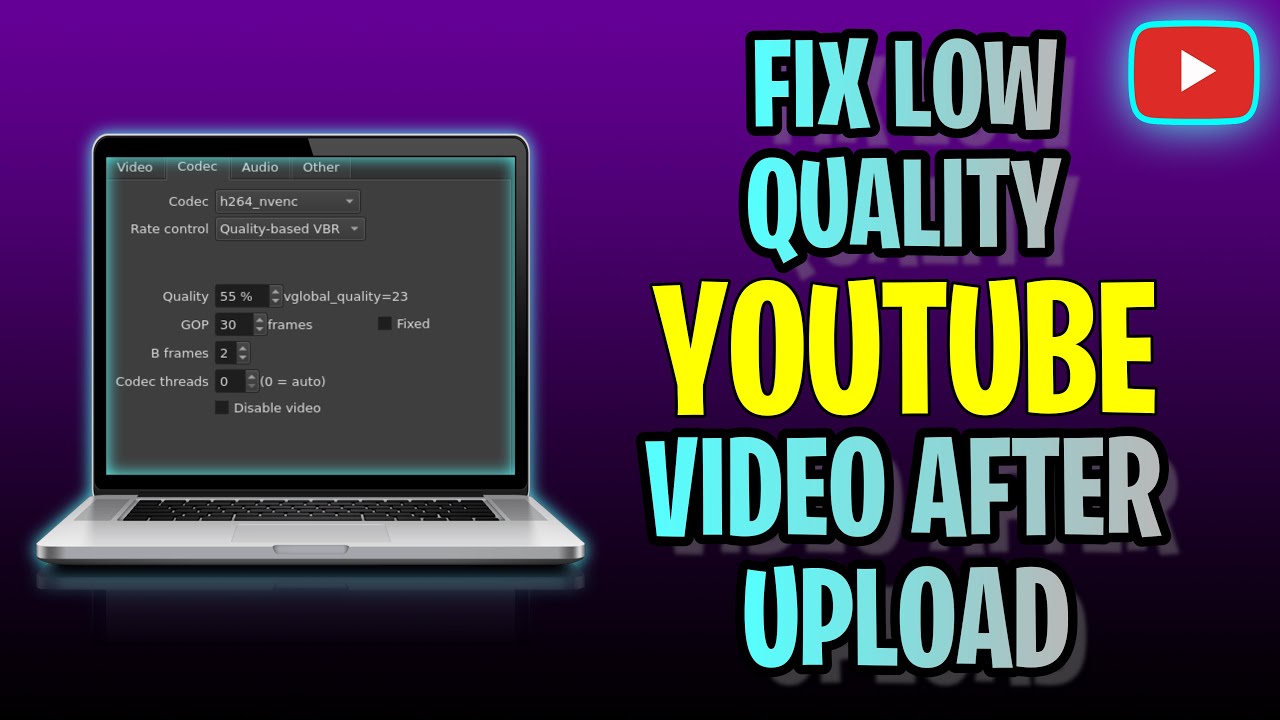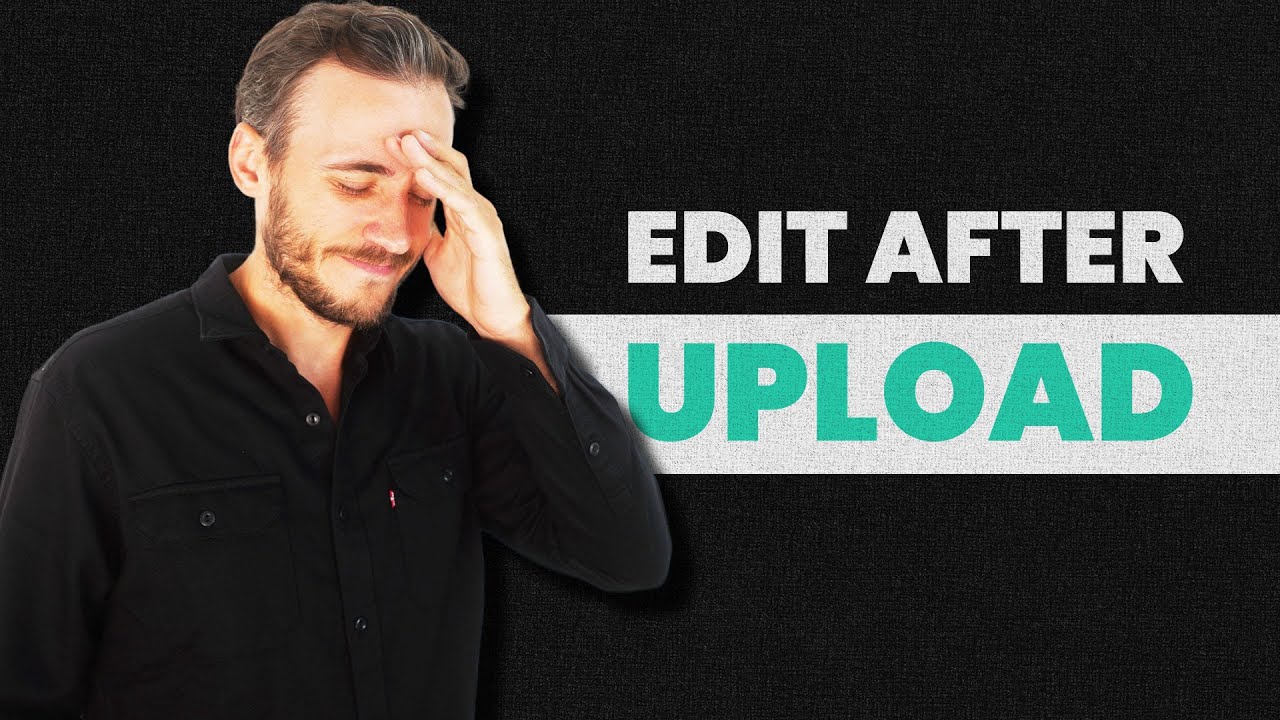Have you ever watched your YouTube video after uploading it and thought, "Oh no, I should have done that differently!"? You're not alone! Many creators find themselves wanting to make changes even after their videos go live. Luckily, YouTube offers several tools to help you tweak your content post-upload. In this blog post, we’ll explore why it’s essential to edit your uploaded videos and how such changes can enhance your channel’s performance.
Why Edit Your Uploaded Videos?

Editing your uploaded videos can serve multiple purposes. Here are a few compelling reasons to consider:
- Improve Quality: Maybe you noticed a mistake or a section that could use a better transition. Editing allows you to refine the overall quality of your content.
- Enhance Viewer Engagement: If you find that viewers drop off at a certain point, you might want to adjust the pacing or remove unnecessary sections. Engaging content keeps your audience glued to the screen.
- Correct Mistakes: Typos in the video description, incorrect facts, or even a missed credit can be fixed. It’s crucial to maintain credibility and professionalism.
- Add Captions or Annotations: Perhaps you want to make your video more accessible. Adding captions or annotations can help viewers understand the content better.
- Optimize for SEO: Updating titles, descriptions, or tags can improve your video's searchability. This means more views and potentially more subscribers!
In essence, editing your videos post-upload not only enhances their quality but also contributes to your channel’s growth and audience satisfaction. So, don’t hesitate to make those changes!
Also Read This: How to Get Rid of Popups on YouTube for a Cleaner Interface
How to Access Video Settings

Accessing the video settings on YouTube is a straightforward process, and it’s essential for making any adjustments to your uploaded content. Here’s how you can do it:
- Log into Your YouTube Account: Start by logging into your YouTube account. You’ll need to be on the site to access your videos.
- Go to YouTube Studio: Click on your profile picture in the top right corner of the screen and select “YouTube Studio” from the dropdown menu. This is your dashboard for managing all your content.
- Find Your Videos: In the left sidebar, click on “Content.” This will take you to a list of all your uploaded videos.
- Select the Video: Locate the video you want to edit. You can use the search bar if you have many videos. Click on the video title or the pencil icon (which represents “Edit”).
- Access Video Settings: Once you’re on the video details page, you’ll find various options like “Details,” “Monetization,” “Subtitles,” and more. Click on “Details” to access the specific settings for your video.
And there you have it! Now that you’re in the video settings, you can start making your adjustments. Whether you want to change the thumbnail, add tags, or tweak visibility settings, everything is just a few clicks away.
Also Read This: Changing Colors on the SeeStar S50 Image
Editing Video Titles and Descriptions
Editing your video titles and descriptions is crucial for improving your video’s visibility and engagement. Here’s a simple guide on how to do it effectively:
- Access Video Settings: Follow the steps mentioned above to get to your video settings in YouTube Studio.
- Edit the Title: In the "Details" section, you’ll see the title of your video. Click on the title box to make changes. Aim for titles that are catchy and relevant!
- Optimize Your Description: Below the title, there’s a description box. This is your chance to provide more context about your video. Include keywords, links, and other relevant details. A well-structured description might look like this:
- Introduction: Brief overview of the video.
- Main Content: Key points discussed.
- Call to Action: Encourage viewers to like, subscribe, or follow links.
- Utilize Tags: In the same section, you can add tags that relate to your content. Tags help YouTube understand your video and promote it in related searches.
- Save Changes: Don’t forget to click “Save” after you’ve made your edits to ensure all changes are applied.
By optimizing your titles and descriptions, you’re not only making your videos more appealing but also increasing their chances of being discovered by a wider audience. Happy editing!
Also Read This: How Much Is 40 Million Views on YouTube Worth
Updating Thumbnail Images
One of the easiest ways to make your YouTube video more appealing is by updating the thumbnail image. A captivating thumbnail acts like a mini-advertisement for your video. It can significantly affect whether viewers click to watch or scroll past. Here’s how to update your thumbnail effectively:
- Choose Eye-Catching Images: Select images that represent the content accurately while being visually appealing. Bright colors and clear images typically perform better.
- Text Overlay: Sometimes, adding a few words to your thumbnail can spark curiosity. For example, phrases like "Must Watch!" or "Shocking Reveal!" can entice clicks.
- Consistency: Use a consistent style for your thumbnails across your channel. This helps in brand recognition and makes your videos easily identifiable.
- Use Custom Thumbnails: While YouTube automatically generates thumbnails, uploading a custom one can significantly improve your video’s performance.
To update your thumbnail, simply go to the YouTube Studio, select your video, and click on the "Thumbnail" section. Remember, a well-designed thumbnail can increase your video’s watch time and engagement!
Also Read This: How to Use the Nikon D5200 for Beginner Photographers
Adjusting Video Privacy Settings
Privacy settings play a crucial role in controlling who can see your content on YouTube. After uploading a video, you might want to tweak these settings based on your audience or strategy. Here’s what you need to know:
| Privacy Setting | Description |
|---|---|
| Public | Your video is visible to everyone. This is ideal for content meant for broad audiences. |
| Unlisted | Only those with the link can view your video. Great for sharing with specific groups without public visibility. |
| Private | Your video is only visible to you and selected users. Useful for personal projects or content not ready for public consumption. |
You can adjust these settings anytime from the YouTube Studio. Just click on your video, select “Visibility,” and choose your preference. Keeping your audience in mind while making these adjustments can ensure that your content reaches the right viewers!
Also Read This: How to Retrieve and Use the Script of Any YouTube Video
7. Adding or Removing Video Tags
Tags are like little signposts that guide viewers to your video. They help YouTube understand the content and context of your video, making it easier for people to find it through search. Adding or removing tags after uploading your video can significantly impact its reach and discoverability.
When you upload a video, you might initially think of a few tags, but over time, you may realize that some tags are more effective than others. Here’s how you can manage your video tags:
- Adding New Tags: If you find new keywords or phrases that are relevant to your video, you can add them to enhance visibility. Make sure to choose tags that accurately reflect the content to avoid misleading viewers.
- Removing Ineffective Tags: If certain tags aren’t drawing in the audience, consider removing them. This can help streamline the video’s metadata and improve its overall performance.
- Keep It Relevant: Always ensure that your tags match the video content. Irrelevant tags can lead to viewer dissatisfaction and potentially hurt your video’s rankings.
To add or remove tags, go to YouTube Studio, select your video, and edit the “Tags” section. Remember, a strategic approach to tagging can be the difference between your video being seen or getting lost in the shuffle!
Also Read This: Why Do YouTube Videos Play with Video Tag Interaction Muted? Explained
8. Using YouTube’s Video Editor
YouTube offers a built-in video editor that can be a game-changer for creators. It allows you to make various adjustments to your videos post-upload without needing external software. Whether you're looking to trim a bit of footage, add music, or include text overlays, the video editor has got you covered.
Here’s how you can leverage YouTube’s Video Editor:
- Trimming Clips: If there are parts of your video that don’t quite fit, you can easily trim the beginning or end. This is perfect for polishing your video without re-uploading.
- Adding Music: Want to spice up your video? You can add royalty-free music from YouTube’s audio library. This feature enhances the viewing experience and keeps your content engaging.
- Inserting Text or End Screens: You can also add text overlays or end screens to promote other videos, encouraging viewers to stick around for more of your content.
To access the editor, go to YouTube Studio, select your video, and click on “Editor.” It’s user-friendly, and you can see changes in real-time. With YouTube’s Video Editor, you have the power to make your videos even better, ensuring they resonate well with your audience!
Making Changes to Your YouTube Video After Upload
Uploading a video to YouTube is just the beginning of your content creation journey. Sometimes, you may want to make adjustments to your video even after it has been published. Fortunately, YouTube offers several features that allow creators to modify their content post-upload. Here are the key areas where you can make changes:
- Title and Description: You can edit the title and description of your video to better reflect its content or improve SEO.
- Thumbnail: Change your video thumbnail to make it more appealing or relevant. This is important for attracting viewers.
- Tags: Adding or changing tags can help your video reach a broader audience by improving its discoverability.
- End Screens and Cards: These interactive elements can be added or modified to promote other videos or channels, enhancing viewer engagement.
- Subtitles and Closed Captions: You can add or edit subtitles to make your content more accessible to a diverse audience.
For more significant changes, such as altering the video's content itself, you might need to use YouTube's built-in video editor. This allows you to trim sections, blur sensitive information, or add music and effects. However, be mindful that some edits may take time to process and could impact your video's reach.
| Change Type | Availability |
|---|---|
| Title | Yes |
| Description | Yes |
| Thumbnail | Yes |
| Tags | Yes |
| End Screens & Cards | Yes |
In conclusion, making changes to your YouTube video after uploading is not only possible but also essential for keeping your content relevant and engaging. Take advantage of these features to ensure your audience gets the best experience possible.
 admin
admin








